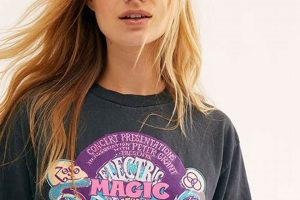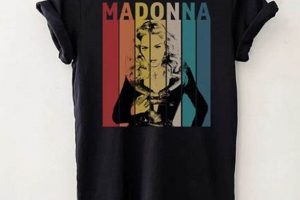Garments of a specific style, characterized by a buttoned front, short sleeves, and design aesthetics reflecting previous eras, represent a distinct segment of apparel. These items, often constructed from materials and exhibiting patterns common to earlier decades, offer a tangible link to fashion history. An example would be a 1950s-era rayon shirt with a camp collar and atomic print.
The enduring appeal of these garments stems from several factors. They provide an opportunity to express individuality and a connection to a perceived simpler time. Furthermore, the often superior construction and unique fabrications found in older pieces offer a level of quality rarely seen in contemporary mass-produced clothing. Their resurgence mirrors a broader interest in sustainability and the cyclical nature of fashion trends. This appreciation also offers insight into evolving cultural values and sartorial preferences throughout history.
Further exploration will delve into the characteristics that define authenticity, the criteria for assessing condition, and the best practices for care and preservation. Guidance on sourcing reliable vendors and identifying key design elements across various periods will also be provided.
Essential Considerations
Proper assessment and care are paramount when dealing with garments from previous eras. These considerations ensure longevity and preservation of value.
Tip 1: Material Identification: Determine the fabric composition. Rayon, cotton, linen, and blends were commonly used. Knowing the material dictates appropriate cleaning methods. For instance, vintage rayon often requires gentle hand washing or professional cleaning to prevent shrinkage.
Tip 2: Condition Assessment: Examine the garment for damage. Tears, stains, and weakened seams are common. Small repairs can often be made; however, extensive damage may detract from value and wearability. Note any flaws in detail within descriptions when considering resale.
Tip 3: Sizing Discrepancies: Recognize that sizing standards have evolved. A vintage “medium” may fit smaller than a modern counterpart. Consult measurements (chest, shoulders, length) rather than relying solely on labeled size. Compare measurements to similar modern garments.
Tip 4: Hardware Integrity: Assess the condition of buttons and closures. Original buttons are a key detail. Missing or damaged buttons diminish value. Consider carefully sourcing replacement buttons that are as close as possible to the original to maintain authenticity. Note any damage to closures like zippers or snaps.
Tip 5: Storage Practices: Store the garment properly to prevent damage. Use padded hangers for shirts to maintain shape. Avoid direct sunlight, which can cause fading. Store in a cool, dry place, preferably in a garment bag, to protect from dust and pests. Cedar closets or cedar chips can aid in pest prevention.
Tip 6: Cleaning Protocols: Exercise caution when cleaning. Many vintage fabrics are delicate. Dry cleaning is often the safest option for fragile materials. When in doubt, consult a professional cleaner specializing in vintage textiles. Avoid harsh chemicals or excessive heat during any cleaning process.
Tip 7: Pattern and Era Identification: Learn to recognize common patterns and styles associated with different eras. This knowledge assists in determining authenticity and value. Examples include camp collars (1950s), Hawaiian prints (1940s-1960s), and geometric patterns (1970s).
Adherence to these recommendations ensures the preservation of both the garment and its historical significance. Diligence in identification, assessment, and care maximizes its lifespan.
Subsequent sections will provide guidance on sourcing authentic examples and navigating the vintage market.
1. Era Identification
Era identification is a cornerstone in the study and appreciation of garments of a specific style. The manufacturing period significantly influences the materials used, construction techniques employed, prevailing styles reflected, and overall value attributed to the piece. Accurately determining the era allows for informed assessments of authenticity and historical significance. An example is the transition from natural fibers like cotton and linen in earlier decades to the increased use of synthetic materials like rayon and polyester in the mid-20th century. The presence of specific fabrics directly corresponds to the time of manufacturing. Ignoring era identification leads to mischaracterization and potentially incorrect valuations of an item.
The cut, collar style, and print patterns provide further chronological markers. For instance, a camp collar and boxy cut are strongly associated with the 1950s, whereas pointed collars and slim-fit designs were more common in the 1960s. Print aesthetics also provide temporal clues. Bold Hawaiian prints were popular during the post-war period, while geometric patterns were more prevalent in the 1970s. Variations in button materials and manufacturing techniques can also reveal the age of a specific piece. Plastic buttons became widespread in the mid-20th century, replacing earlier materials like shell or bone in many garments. Observing the subtle changes in the button’s design or manufacturing technique can aid in narrowing down the creation date, and therefore allow the person to identify the Era, the era influences the characteristics of the items.
The importance of era identification extends beyond mere categorization. It informs proper care and preservation techniques. Understanding the materials and construction methods helps in determining the most appropriate cleaning methods and storage conditions. Furthermore, accurate era identification is vital in the context of resale and collecting. It enables informed pricing strategies and ensures that items are represented accurately to potential buyers or collectors. The interplay between era identification and material analysis, design elements, and manufacturing techniques provides a comprehensive understanding of these unique garments, enhancing appreciation for their historical and aesthetic value.
2. Fabric Composition
Fabric composition is a defining characteristic of vintage garments, directly impacting durability, drape, and overall aesthetic. Within the specific category, material choices reflect the technological advancements and prevailing textile trends of different eras. Understanding these compositional nuances is crucial for accurate dating, appropriate care, and assessing value.
- Natural Fibers: Cotton and Linen
Prior to the widespread adoption of synthetics, cotton and linen were prevalent. Cotton offered affordability and breathability, while linen provided durability and a crisp texture. Examples include lightweight cotton voile shirts from the 1940s or sturdy linen button-downs from the early 20th century. Their presence typically indicates an older piece, requiring gentle cleaning methods to prevent damage.
- Rayon: A Mid-Century Staple
Rayon, a semi-synthetic fiber, gained prominence in the mid-20th century as a cost-effective alternative to silk. It offered a smooth drape and vibrant color retention, often seen in bold Hawaiian prints of the 1950s and 1960s. However, rayon is prone to shrinkage and requires careful handling, making proper identification crucial for appropriate cleaning.
- Synthetic Blends: Polyester and Beyond
The introduction of fully synthetic fibers like polyester and nylon marked a shift towards increased durability and wrinkle resistance. Blends of these synthetics with natural fibers became common, resulting in garments that were easier to care for. While durable, these blends often lack the breathability of pure natural fibers and contribute to a different tactile experience, influencing overall desirability among collectors.
- Silk: Luxury Material
Silk was used in luxury garments, but they are relatively fragile, and rare to see. Silk shirts are very smooth and feel soft to touch.
The selection of materials directly influences the garment’s lifespan and care requirements. While cotton and linen offer breathability, they are susceptible to wear and tear. Rayon provides vibrant colors but demands gentle handling. Synthetic blends offer durability but lack the tactile qualities of natural fibers. Accurate identification of the fabric composition informs informed decisions regarding acquisition, preservation, and valuation, allowing for a deeper appreciation of their historical and aesthetic value.
3. Collar Styles
Collar styles represent a significant design element that provides critical insight into the era and intended purpose of garments of a specific style. The evolution of collar designs closely mirrors changing fashion trends and societal norms, making them a valuable diagnostic tool for dating and authenticating items. These styles are not merely aesthetic choices; they reflect functional requirements and cultural preferences prevalent during specific periods.
For example, the camp collar, characterized by its open, relaxed design, was highly popular in the 1950s and 1960s. This style often appears on rayon shirts featuring bold prints, reflecting a casual, post-war aesthetic. Conversely, pointed collars, typically starched and more structured, were common in earlier decades, conveying a more formal appearance. The adoption of the button-down collar, initially designed for polo players to prevent their collars from flapping, illustrates how practical considerations can influence fashion trends. Identifying the distinct variations in collar design helps to pinpoint the manufacturing era and understand the intended use of the apparel.
Knowledge of collar styles aids in both the identification of authentic vintage pieces and the proper care of these items. Different collar designs necessitate specific cleaning and pressing techniques to maintain their shape and integrity. Furthermore, in the context of collecting and resale, the presence of correct and well-preserved collar styles significantly impacts the value of an item. The careful examination and understanding of collar styles provides a deeper appreciation for the design and historical significance and ensure the longevity of these unique garments.
4. Print Aesthetics
Print aesthetics represent a crucial aspect of garments of a specific style from previous eras. The designs adorning these items serve as visual timestamps, reflecting prevailing artistic movements, cultural attitudes, and technological capabilities of their respective periods. An analysis of print aesthetics reveals a direct correlation between the designs on shirts and the socio-historical context in which they were produced. The vibrant Hawaiian prints prevalent on shirts from the 1940s-1960s, for example, embody the post-war fascination with exotic locales and the burgeoning tourism industry. Conversely, the geometric patterns and psychedelic designs gracing shirts from the 1970s mirror the era’s experimentation with new forms of artistic expression and countercultural movements. The choice of colors, motifs, and printing techniques further contributes to the shirt’s identity, solidifying its connection to a specific time.
The importance of print aesthetics extends beyond mere visual appeal. Authenticity, value, and proper care strategies are all influenced by the print’s characteristics. Recognizing common patterns and printing methods associated with particular decades allows for the identification of genuine specimens and the detection of reproductions. The value of a shirt increases if its print is well-preserved and representative of a sought-after style. Understanding the type of dyes and printing techniques used dictates the appropriate cleaning methods. Delicate or hand-painted prints require specialized care to prevent fading or damage. Moreover, the garment’s overall impact as a piece of wearable art is significantly enhanced when its print is understood within its historical framework.
In summary, print aesthetics constitutes an essential element in the study and appreciation of garments of a specific style, linking the garments to cultural touchstones and historical contexts. Challenges arise in discerning subtle nuances in printing techniques and accurately dating designs. These designs not only define the garment’s visual character, but also inform decisions regarding its authenticity, preservation, and overall significance. A comprehensive approach, encompassing print analysis, material assessment, and construction examination, is crucial for obtaining a holistic understanding of the garment.
5. Button Detailing
Button detailing on these types of shirts serves as a significant indicator of age, manufacturing techniques, and stylistic trends. The materials, size, shape, and method of attachment of buttons provide valuable clues about the garment’s origins. Changes in button materials, from natural substances like shell and bone to early plastics such as Bakelite and later iterations of nylon and polyester, correlate directly with specific eras of production. The presence of a particular type of button can often narrow down the manufacturing timeframe and assist in authentication efforts. For example, shirts produced in the early to mid-20th century frequently exhibit buttons made from natural materials, while later garments tend to feature plastic alternatives. Understanding these shifts in material usage allows for a more accurate assessment of the garment’s vintage character.
Button detailing also contributes to the aesthetic and functional aspects of these garments. The size and shape of buttons can influence the overall style and visual appeal. Smaller, more delicate buttons may suggest a finer quality garment, while larger, more utilitarian buttons may be indicative of workwear or casual attire. The method of attachmentwhether hand-sewn or machine-attachedcan also reveal details about the manufacturing process and the garment’s intended market. Furthermore, the presence of specific button designs, such as those with unique patterns or logos, can add to the garment’s historical significance and collectibility. The replacement of missing or damaged buttons with historically accurate alternatives is crucial for preserving the integrity and value. A shirt with mismatched or modern buttons detracts from its authenticity.
In summary, button detailing represents a key factor in understanding and appreciating garments of this kind. Analysis of button materials, design, and attachment methods provides insight into the garment’s era, style, and intended purpose. While challenges exist in accurately identifying and sourcing replacement buttons that match the originals, the attention to button detailing ensures the preservation of the garment’s aesthetic and historical value. Integrating the study of buttons with an examination of fabrics, collar styles, and print aesthetics yields a more comprehensive understanding of shirts from previous eras.
Frequently Asked Questions
This section addresses common inquiries regarding the identification, care, and valuation of garments characterized by a buttoned front, short sleeves, and design aesthetics reflecting previous eras. The information provided aims to clarify misconceptions and offer practical guidance for enthusiasts and collectors.
Question 1: What criteria define an item as “vintage”?
Generally, an item must be at least 20 years old to be considered vintage. However, the term is often applied more broadly to items that are representative of a specific era and no longer in mainstream production. The perceived style and design contribute to the categorization.
Question 2: How does one differentiate a genuine garment from a reproduction?
Examination of fabric composition, construction techniques, and hardware (buttons, closures) is critical. Reproduction typically exhibits modern materials and manufacturing processes. Original pieces will often show signs of wear consistent with their age. Researching period-specific details helps in accurate assessment.
Question 3: What cleaning methods are recommended for delicate fabrics?
Dry cleaning is generally the safest option for fragile materials such as rayon or silk. Hand washing with a mild detergent is possible but requires extreme caution. Avoid harsh chemicals, high heat, and aggressive agitation, as these can damage delicate fibers.
Question 4: How should these items be stored to prevent damage?
Storing shirts on padded hangers preserves their shape. Garments should be kept away from direct sunlight and moisture. Storing them in garment bags offers protection from dust and pests. Cedar chips or closets can deter moths.
Question 5: Does the condition of a piece significantly affect its value?
Condition is a primary factor in valuation. Items in excellent or near-mint condition command higher prices. Damage such as tears, stains, or missing buttons detracts from value. Note that minor imperfections can be acceptable and even expected in older items.
Question 6: What resources are available for researching styles and identifying authentic pieces?
Archival fashion publications, museum collections, and online resources dedicated to costume history offer valuable insights. Consulting with experts specializing in clothing from previous eras provides additional guidance. Examining examples in person whenever possible enhances familiarity with authentic details.
Key takeaways: Accurate identification, proper care, and diligent storage are essential for preserving the value and longevity of these garments. Research and consultation with experts enhance decision-making regarding acquisition and preservation.
The subsequent section will offer resources and recommendations for sourcing authentic examples in the vintage market.
Conclusion
The preceding exploration of “vintage short sleeve button down shirts” has underscored the multifaceted nature of these garments. The examination of era identification, fabric composition, collar styles, print aesthetics, and button detailing reveals the significance of each element in determining the authenticity, value, and proper care protocols for these items. Attention to these details ensures the longevity of these pieces of wearable history.
As interest in distinctive apparel endures, understanding the intricacies of these garments becomes increasingly crucial. Whether acquiring for personal enjoyment or collecting for historical preservation, diligent study of stylistic nuances and construction methods is recommended. Appreciation of these qualities will serve to uphold the legacy and historical significance of “vintage short sleeve button down shirts” for generations to come.







